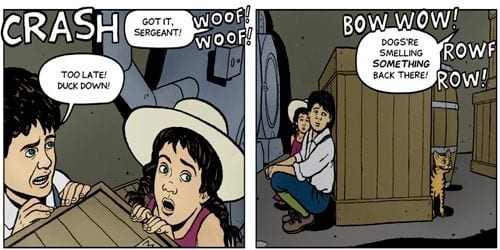
I didn’t plan on buying Pood #1. As a poor teacher and writer I don’t have a lot of extra money to risk on some weird art comic that I’ve never heard of, collecting the works of creators I haven’t seen before (if I was rich I would love to buy more comics, but when you’re broke you have to sacrifice). So I wasn’t planning on buying this comic, but it forced me to. For starters, it was printed in a giant newspaper format – how cool is that?. Secondly, it had some great artwork in it. Last, it was only 4 bucks. I was helpless to resist.
As far as small press anthologies go, this one if fairly typical content wise; there is some bad stuff, some good stuff, and some great stuff. Although I don’t meander on over to the indy side of the comic store to mingle with my geek cousins in the art comic crowd as much as I’d like, the few times I’ve grabbed a collection like Pood, I had the same mixed experience.
Some stuff is magnificent, and other stuff is so strange and weird that I’m not sure if its just that I don’t get it, or if its some hipster plot and nobody really gets but we’re all too afraid to admit it. While there are some sections that might leave readers like me scratching their heads, or screaming WTF!?, there are also some wonderful selections by some gifted artists and storytellers.
Another wonderful thing about Pood is the sense of immediacy that comes from reading it. Unlike some other comics out there, where each singular book is just one part of an larger interconnected web of continuity and mythology spanning back decades in some cases, while simultaneously looking forward to the next epic, universe-altering crisis, the comics in Pood represent an entire creative universe all by itself, the sum total of which is captured on a single page.
Consequently, there is no looking backward, or foreword, there is only that singular moment of reading. This allows the reader to scrutinize the artwork with greater attention to detail then they might with other comics, analyzing and being critically engaged with the story in a way that is not necessarily better, but different from more mainstream books. Even the selections that the reader might not like as much as others still demand you give them their due consideration.
This sense of immediacy is only reinforced by the newspaper style of the format. In a time of iPads, e-readers, and digital comics, it is often easy to forget the tactile component in the reading process. The aesthetic quality of Pood is pleasantly intrusive, forcing the reader to turn and fold their way through the huge pages, keeping them constantly engaged in the act.
Devices like the Kindle are designed to make you forget that you’re reading Pride and Prejudice off a non-reflective e-ink display, painstakingly designed to emulate a piece of paper; part of the success of the Pood is from its reliance on your constantly being aware of the medium on which you are reading it.
So, I am pleased to say, even though this book tricked me into buying, it turned out to be money well-spent. Pood #1 is a solid anthology that showcases an eclectic group of artists and writers, and is published in a way that enhances the reading experience. The content is a strong display of the power of the medium, while the format is a wonderful reminder of the tactile pleasure of reading in our sometimes too digital world.

![Call for Papers: All Things Reconsidered [MUSIC] May-August 2024](https://www.popmatters.com/wp-content/uploads/2024/04/all-things-reconsidered-call-music-may-2024-720x380.jpg)



